Group 3 |
Compact panicle forming a single spike: cylindrical, oval or spherical |
27 species in our area: Echinaria, Phalaris, (Cynosurus—see group 1), Tragus, Setaria, Sesleria, Rostraria, Koeleria, Dactylis, Anthoxsanthum, Polypogon, Gastridium, Phleum, Alopecurus, | A pedicel (stalk under each spikelet) is present, but not initially easy to see | ||
| Either:- |
Inflorescences in characteristic shape: |
Inflorescence like a sea-urchin |
Echinaria capitata : A.
Species identified. Congratulations! |
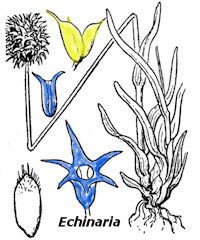
|
|
| or:- |
Spikelets male/sterile around a (hermaphrodite) fertile
spikelet
|
Group 3a | |||
| or:- |
Spikelets containing a single hermaphrodite floret (+/- sterile
florets); ligules with hairs
|
Group 3b | |||
| or:- |
Spikelets with several hermaphrodite florets; ligules without
hairs
|
Group 3c | |||
| or:- |
Spikelets containing a single hermaphrodite floret (+/- sterile
florets); ligules without hairs
|
Group 3d |
Group 3 (a) |
Spikelets male/sterile around a (hermaphrodite) fertile spikelet |
||||
| Either:- | Spikelets with 1 floret (hidden by the glumes), 2 sterile florets, scale-like |
Phalaris spp.: A. & P.
Genus identified. Consult FlorMed or other flora to determine which species |
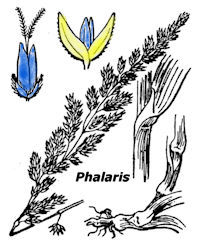
|
||
| or:- |
Spikelets with several florets Inflorescence unilateral, fertile spikelets, and at the exterior, sterile spikelets (acting for protection), both with several florets. |
Cynosurus spp. :A. & P. —see group I
Species identified. Congratulations! |

|
Group 3 (b) |
Spikelets containing a single hermaphrodite floret (+/- sterile florets); ligules with hairs |
May be also one sterile floret | |||
| Either:- | Upper glume short, with hooked hairs; ligules hairy |
Tragus racemosus: A.
Species identified. Congratulations! |
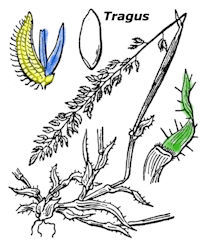
|
||
| or:- | Peduncles (not the spikelets) with long silky awns. Ligules hairy. 2 florets (1 sterile, 1 fertile) hidden by the upper glume. |
Setaria spp. :A.
Genus identified. Consult FlorMed or other flora to determine which species |
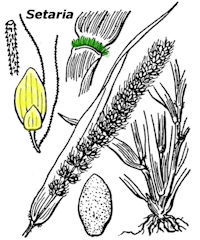
|
Group 3 (c) |
Spikelets with several hermaphrodite florets; ligules without hairs |
||||
| Either:- | Lemmas with a bent dorsal awn |
Trisetum flavescens: P.
Species identified. Congratulations! |
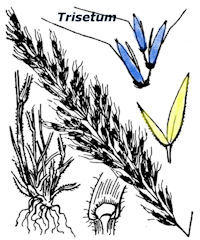
|
||
| or:- | Lemmas with 3 terminal awns |
Sesleria caerulea : P.
Species identified. Congratulations! |
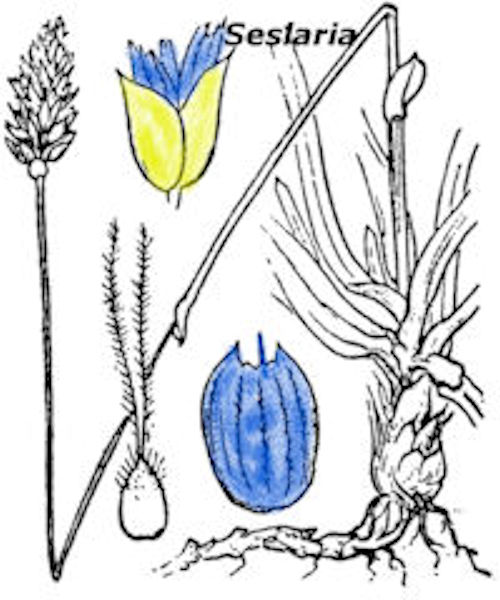
|
||
| or:- | Lemmas with 1 short, sub-terminal awn |
Rostraria cristata : A.
Species identified. Congratulations! |
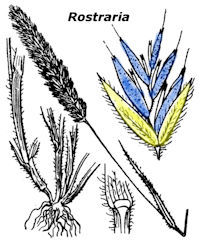
|
||
| or:- | Lemmas apiculate (ending in a short sharp point) |
Koeleria spp. : P.
Genus identified. Consult FlorMed or other flora to determine which species |
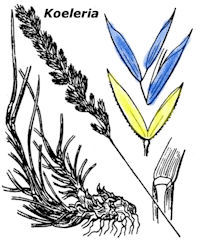
|
||
| or:- | Lemmas with a short awn. Inflorescence unilateral. Glumes and glumelles with a ciliated keel. |
Dactylis glomerata : P. (also shown in group 9)
Species identified. Congratulations! |
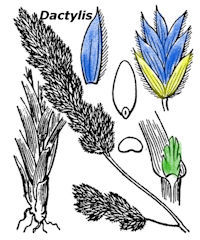
|
Group 3 (d) |
Spikelets containing a single hermaphrodite floret (+/- sterile florets); ligules without hairs |
May be sterile florets | |||
| Either:- | Spikelet with a single hermaphrodite floret, hidden by 2 sterile florets, with a long awn on the back |
Anthoxsanthum odoratum : P.
(Single) genus identified. Consult FlorMed or other flora to determine which sub-species |
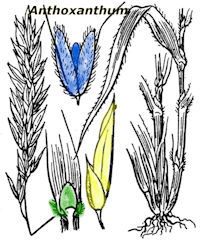
|
||
| or:- | Panicle silky, due to glumes with long silky awns (deciduous). Glumes very ciliated at the summit. |
Polypogon spp. : A.
Genus identified. Consult FlorMed or other flora to determine which species |
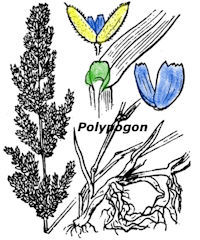
|
||
| or:- | Glumes unequal, swollen at the base, lemmas +/- awn |
Gastridium ventricosum : A.
Species identified. Congratulations! |
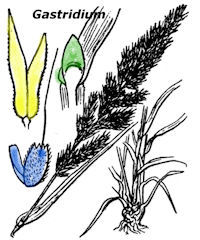
|
||
| or:- | Glumes keeled, ciliated on the keel, awned and not fused, paleas with a thin membrane and 2-toothed (not silky, no awn) |
Phleum spp. : P. & (A.)
Genus identified. Consult FlorMed or other flora to determine which species |
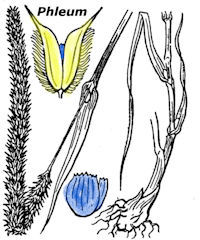
|
||
| or:- | Glumes keeled, fused at the base, paleas absent (not silky, no awn) |
Alopecurus spp. : P. & A.
Genus identified. Consult FlorMed or other flora to determine which speciesSpecies identified. Congratulations! |
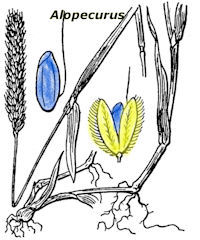
|
Whoops! Not a grass? Return to rushes and sedges!
-
Return to summary of groups
-
or Start again
THE END - I do hope you found what you were looking for